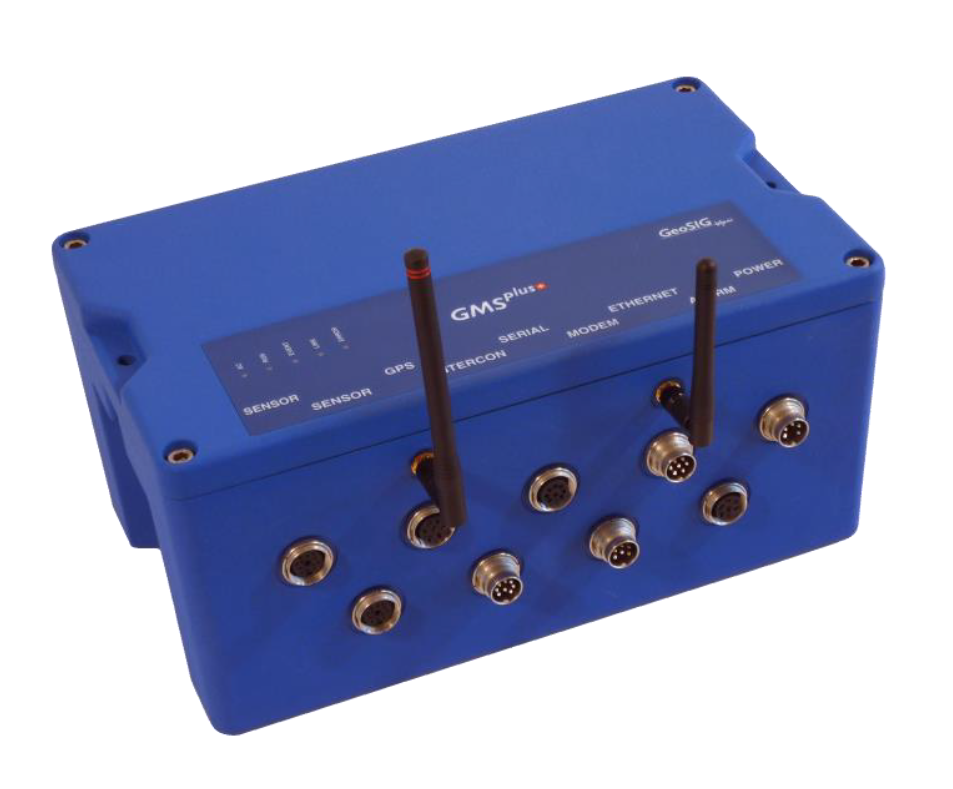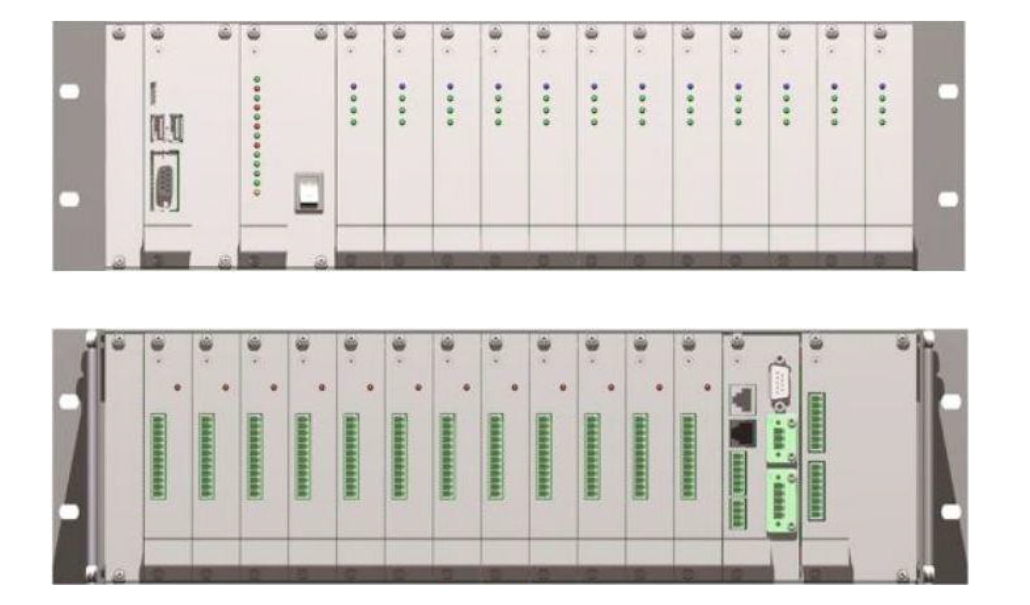Registrars and digitizers
GMSplus Measuring system

Broadband Seismic, Earthquake and Structural measuring and monitoring
Real-time Seismology for Freefield and Urban Areas
High Density Earthquake Monitoring Networks
Shake / Hazard Mapping based on Instrumental Data
Earthquake Early Warning and Rapid Response
Damage Estimation, Disaster Management
Seismic Alarm and Safe Shutdown
Ambient Vibration Testing (optionally fully wireless)
Induced Vibration Monitoring and Notification
Building Code Compliant Instrumentation
Features
- 1 Second generation of NetQuakes Recorder
- 2 3 or 6 channels, up to 1000 sps sampling rate
- 3 Low noise individual 24-bit Δ−Σ ADC per channel
- 4 Internal built-in and/or external sensors
- 5 Wired Ethernet, Wi-Fi and Serial links
- 6 Smart NTP timing, GPS time base, or time synchronisation via radio channel or cable
- 7 Enhanced connectivity via landline modems, 3G cellular devices and satellite links
- 8 Recording to SD or CF cards, up to 128 GByte
- 9 USB interface for external storage and communication devices
- 10 Continuous data recording to ringbuffers
- 11 Flexible configuration of multiple triggers
- 12 Simultaneous data streaming to several clients
- 13 On board data processing and evaluation
- 14 Rugged aluminium housing with levelling base plate for easy installation
- 15 Configuration and status monitoring via Web Interface compatible with Smartphones
- 16 Simple and secure communication over Internet with full remote management
- 17 Internal battery, low power consumption
- 18 Alarm output with up to 4 relays flexibly configurable for different types of events
- 19 Easily configurable interconnected networks with common timing and triggering
Outline
GMSplus is the ground breaking latest generation of the GeoSIG Measuring Systems with highest performance, excellent operational flexibility and enhanced connectivity.
The unit is based on the GMS technology of NetQuakes Seismographs, which are developed in close coordination with USGS, and deployed in high quantities in North America establishing the NetQuakes network.
It includes an Ethernet connection and optionally a Wi-Fi (b/g/n) module to ensure fast and reliable data transfer. Both wired and wireless network interfaces can be used simultaneously.
Its design and efficiency makes it the first choice for any application requiring seismic instruments. With its optimized installation, operation and maintenance philosophy, the GMSplus offers the real possibility to implement high density arrays with total costs at a small fraction of conventional strong-motion seismograph networks.
The instrument’s software processes data in real time. If triggered by a seismic event, GMSplus calculates a number of Event Parameters and reports them to a data centre immediately.
GMSplus is a self-contained instrument and is equipped with an uninterruptible power-supply, which provides more than 24 hours autonomy.
The GMSplus uses an “Intelligent Adaptive Real Time Clock” (IARTC) with self-learning temperature compensation, improving the accuracy of the RTC or TXCO significantly. The IARTC is able to synchronize with GPS or NTP to UTC timing to provide high timing accuracy. Optionally the unit itself can act as an NTP server as well.
The instrument can be locally connected to a laptop through its ports for configuration, testing or data retrieval. Same functions are available remotely as well.
Wired or Wireless Interconnected Network options enable the use of several units together in a time and trigger synchronised manner. The optional USB support enables the user to connect various external devices such as high capacity storage devices, 3G modems, etc.
CR-6plus Multichannel Central Recording System

Structural Health and Response Monitoring
Earthquake and Seismic Monitoring
Ambient Vibration Testing
Induced Vibration Monitoring and Notification
Building Code Compliant Instrumentation
Seismic Alarm and Safe Shutdown
Features
- 1 Unlimited number of channels by combining modular (12 x 3) 36 channel modules
- 2 137 dB dynamic range
- 3 Individual 24-bit Δ−Σ ADC per channel
- 4 Up to 500 sps adjustable sampling rate
- 5 Recording on microSD cards
- 6 USB interface for external storage and communication devices
- 7 Continuous and trigger based recording
- 8 Simultaneous data streaming to several clients
- 9 Wired Ethernet, optional enhanced connectivity via external landline modems, 3G cellular devices, satellite links and serial links
- 10 TCXO time base with GPS or NTP synchronisation
- 11 Configuration and status monitoring via Web Interface compatible with Smartphones/Tablets
- 12 Simple and secure communication over internet or intranet with full remote management
- 13 Optionally available as drop-in replacement for CR-4 Digitiser
- 14 Connection of sensor cables on terminals
- 15 Optional alarm output with up to 4 independent relays flexibly configurable for different types of events
- 16 Extremely compact and modular
Outline
CR-6plus is a modern multichannel central monitoring and recording system including a high performance data handling module, providing an extremely flexible 24 Bit multichannel recorder.
Its design is based on years of experience in creating solutions for earthquake, seismic, structural, dynamic and static monitoring.
Its modular architecture and industry standard interfaces offer high versatility, easy expansion, upgradeability, and long term availability of spare parts.
Connection of the sensor cables is extremely easy and fast with the versatile cable screw terminal design. All inputs and outputs of the CR-6plus are protected with a field proven over voltage protection (OVP) system.
Data from acceleration, velocity, displacement, strain, meteorological or any other type of sensors can be monitored and recorded with superior data quality.
The CR-6plus continuously monitors the real-time data, which can be recorded based on event detection and continuously. The continuous ring buffer size, the prevent and post-event time, trigger thresholds and many other parameters are fully user configurable.
In addition to the real-time display of the measured data from each channel the system can provide statistical data such as mean, max, min, and peak values.
CR-6plus can optionally compare the monitored data to four fully independent alarm trigger criteria and provide relay outputs.
GeoDAS, a proven data acquisition and evaluation package developed by GeoSIG, complements CR-6plus providing a highly flexible user-friendly capabilities, and graphical, analytical and reporting tools with automation.
